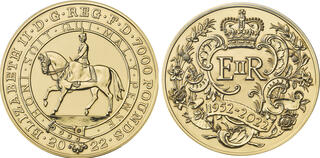| Stack's Bowers Galleries (& Ponterio) > January 2024 NYINC Auction | Auction date: 12 January 2024 |
| Lot number: 52255 Price realized: 550,000 USD (Approx. 501,545 EUR) Note: Prices do not include buyer's fees. | Show similar lots on CoinArchives Find similar lots in upcoming auctions on |
| Lot description: GREAT BRITAIN. Gold 7 Kilogram Platinum Jubilee Commemorative (7000 Pounds), 2022. Llantrisant Mint. Elizabeth II. GEM PROOF. This unique masterpiece is perhaps the most significant modern issue from The Royal Mint to be offered publicly. Produced in 7 kilograms of .999 fine gold and measuring a massive 185mm in diameter, it is as visually spectacular as it is historically significant. This piece was created in celebration of Her Majesty Queen Elizabeth II's Platinum Jubilee, which marked the 70th anniversary of her accession to the throne on 6 February 1952. In the seven decades since, the world had seen her grow from a young queen crowned in post-war Britain, into a widely respected Head of State and a loving great-grandmother. Under Queen Elizabeth II's leadership, the monarchy adapted to the modern era while preserving its historical traditions and constitutional role. Her reign was marked by profound historical events, cultural shifts, and remarkable achievements including the expansion of the British Commonwealth and the transition from empire to a more diverse and inclusive society. As the longest serving monarch in British history, Queen Elizabeth II has left an indelible mark on the United Kingdom and the world which will continue to inspire generations to come. And much like this legacy, the present gold 7 kilo commemorative coin is unique and without parallel. Large gold coins have long been used to recognize and celebrate head's of state going back thousands of years to the very beginnings of coinage. Perhaps the most famed from antiquity are the large gold octodrachms first struck by the Ptolemaic dynasty in Egypt shortly after the death of Alexander III the Great in 323 BC. This oversized format was also adopted by several Roman emperors who struck large multiple-aurei gold medallions during the second quarter of the first millennium AD. This tradition was elevated to new heights beginning in the 16th century when gargantuan medallic multiple-ducats were struck by the Kings of Austria, Germany, and Poland. Large gold coins also have a storied legacy within British numismatics specifically, perhaps the most famous of which are the large gold Una and the Lion 5 Pound coins struck beginning in 1839 to commemorate the ascension of Queen Victoria in 1837. A century later, an unforeseen rarity was created by the premature striking of gold 5 pound coins to mark the coronation of King Edward VIII, who ultimately abdicated the throne five months shy of coronation. While both the Una and the Lion and the King Edward VIII 5 pound coins are prized treasures, their respective rarities pale in comparison to this unique 7 kilo masterpiece celebrating Queen Elizabeth II. The Production and design of this piece required hundreds of hours of craftsmanship and utilized state-of-the-art engraving and laser technology. Instead of being struck on a press between two dies like a traditional coin, the details of this piece were cut into a solid gold ingot by a high-speed precision computer numerical control (CNC) engraving machine. The gold ingot originally began at a weight between 9 and 10 kilograms before being machined into the 7 kilo finished product over several weeks. The master craftsmen at The Royal Mint closely inspected the ingot for quality before positioning it in the CNC machine, which was programed with unique parameters to properly scale the design to this massive format and achieve the technical and aesthetic requirements intended by the designers. It took 3 to 4 days to engrave each side, after which the design was further hand finished over 2 days to remove imperfections and enhance key elements. As a final step, the surfaces were then hand-polished to a high luster over 2 to 3 days before the coin was set into its acrylic mount and oak display case, both of which were produced in the UK. Complementing these advanced production techniques are bespoke commemorative designs on both sides that had been personally approved by The Queen. This numismatic triumph was designed by respected coinage artist John Bergdahl, who has created numerous designs for UK coins including the 2008 Britannia coin, coins celebrating the London 2012 Paralympic and Olympic Games, the £2 coin commemorating Tudor naval ship the Mary Rose, and coins commemorating Magna Carta and the Battle of Hastings. On the obverse of this 7 kilo Platinum Jubilee coin is a special commemorative design depicting The Queen on horseback surrounded by the garter from the Royal Coat of Arms. It draws inspiration from the similar equestrian designs seen on the 1953 coronation crown coin created by Gilbert Ledward RA and the 2002 Golden Jubilee crown by Ian Rank-Broadley FRBS. The reverse depicts a crowned EIIR cypher surrounded by roses, daffodils, thistles and shamrocks, representing the United Kingdom. When reflecting on this special reverse design, Bergdahl explained that he "decided to make use of the royal cypher (EIIR) and looked for a way of differentiating it from the modern more simplistic, minimalistic treatment and adopt a richer, more regal, portrayal. To achieve that, I looked to the past and decided to utilize the kind of rococo cartouche used in the mid eighteenth century." An absolute triumph in every sense, this gold 7 kilo masterpiece combines the pinnacles of rarity, artistry, and minting technology to celebrate the Platinum Jubilee of Queen Elizabeth II. This unique piece is sure to serve as crowning jewel in the most advanced collection of British or world gold coins, and Stack's Bowers Galleries is beyond honored to present this treasure to collectors on behalf of The Royal Mint. Estimate: $600000 - $800000 |  |



